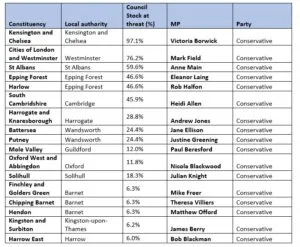Three political problems George Osborne is storing up with the forced sale of council homes
Published: by Steve Akehurst
This morning we published new research on the impact of the government’s proposal to force councils to sell their more valuable social homes. Many of the government’s housing reforms are welcome – but on the affordable housing side of things, some are fairly worrying. This is certainly one of those.
The numbers are pretty grim. 113,000 affordable homes could be lost in exactly the areas of the country they’re most needed.
Recent history, and the financing of the scheme, suggests that these homes are very unlikely to be replaced – and if they are it won’t be on a like-for-like basis in the areas they were lost. Our report has some practical suggestions for mitigating the worst impacts.
The forced sale policy is being pushed by George Osborne in order to generate receipts to fund Right to Buy discounts for Housing Association tenants. Using the sale of one set of social homes to pay for discounts on the sale of another set may seem a smart political move – but it actually unwittingly stores up some serious political problems for the Chancellor.
1. Falls in low income home ownership
As we’ve argued before, council housing combined with the Right to Buy has been the major route to homeownership for people on low incomes. But if the council homes sold are not replaced the next generation will miss out on the Right to Buy – and there is currently nothing else that will give them the chance to buy a home. Soaring house prices mean that even the various forms of ‘intermediate housing’ – such as shared ownership, or the proposed Starter Homes – are simply out of reach for people on typical incomes.
Instead, they find themselves stuck renting private, spending over half their income on rent.
It’s unlikely that a one-time windfall of extending the Right to Buy to HA tenants will reverse this trend.
By forcibly selling council homes to fund other housing schemes, George Osborne may think he is creating a nation of low income home owners, but he is only ensuring future generations of low income people trapped in expensive private renting. The net effect is likely to be that homeownership levels continue to fall.
2. Trouble with backbenchers
You may think this policy would largely hit Labour constituencies, particularly in London.
But in fact, 12 of the top 20 most affected local authorities have Conservative MPs. The table below gives a few examples. By our reckoning there’s around 50 Conservative MPs whose constituencies are more highly affected than the national average.
Fewer affordable homes in these areas means more pressure on the local housing market; more private renters, higher private rents and higher rates of homelessness – all of which means higher rates of casework for the MP, and more constituents for whom housing is a big issue come election time.
Moreover, many of these MPs will not be happy with the fact that funds from assets sold in their constituency will not stay there, but will be pocketed by the Treasury to fund other schemes in other areas.
With a majority of 16, the whips may have a tough job when the Housing Bill does emerge. These are also the people Osborne will need to court if he’s to become the next Conservative leader.
Table 1: Conservative MPs directly affected by the forced sale of council homes
3. Demographic change – in Conservative marginals
Over the last ten years, there has been a slow exodus of lower income people from the centre of our major cities, towards the outer edges – especially in London. The shortage of affordable housing, combined with recent changes to welfare, is undeniably at the root of this. People on typical incomes just can’t afford to live in those areas anymore, so they have to look elsewhere.
This has had knock-on impacts for the political landscape. At the last election, several previously safe Conservative seats bucked the national trend and either went Labour or saw their majorities decreased. Gavin Barwell, who just clung on to his seat in Croydon in May, recently told ConHome:
“In London, the reason we lost Nick and we lost Ange and we lost Mary and we lost Lee” – Nick de Bois, Enfield North; Angie Bray, Ealing Central and Acton; Mary Macleod, Brentford and Isleworth; Lee Scott, Ilford North – “is that London is turning into Paris: the centre is gentrifying and pushing poorer people out. There is a natural demographic challenge there.”
Nick De Bois has also talked about this.
In short, forcibly selling off vast amounts of inner London council homes on the open market will accelerate this demographic change in the coming years. It will almost certainly mean more, traditionally Labour voting low income private renters in Conservative marginals.
In the report (page 28), we highlight 20 local authority areas – based on previous trends and migration flows – who are very likely to see such an influx of low income private renters. These are largely outer London areas, but also cover other nearby towns in the South East. They are all areas whose demographic has already started to shift significantly towards lower income groups.
There are many marginal Conservative constituencies in the mix within those areas, as the below table shows. So, even if they aren’t directly affected, you can add Conservative MPs in those seats to those who will be nervously awaiting the details of the Housing Bill.
Table 2. Conservative-held marginal seats likely to see demographic/socio-economic change as a result of forced sale of council homes

